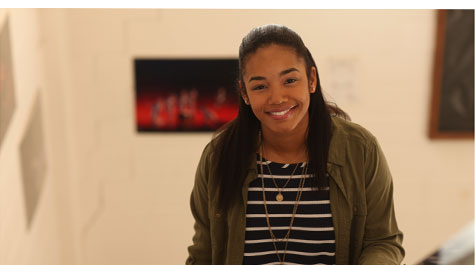Student’s choreography of ‘Trinity’ explores the complexities of relationships
Kayla Weldon ’18 uses choreography to express life’s complexities through dance.
She gets another chance to showcase her piece “Trinity” when fellow students perform it at the upcoming American College Dance Association regional conference at the University of Maryland in March.
William & Mary’s Orchesis Dance Company previously performed it at “An Evening of Dance ” last year.
It’s Weldon’s first piece of choreography and though students often perform at dance conferences, the featuring of student choreography is rare , according to Joan Gavaler, W&M professor and director of dance. “Trinity’s” meaning comes from how Weldon sees relationships, and the notion that they are always far from simple.
“I wanted to do something very personal to me,” she said. “And so originally I was drawn to ideas of the African-American experience, or the experience as a young woman, just things that are very key parts of my identity.
“And that kind of led me to a place of the Baptist church just because I spent a lot of my childhood growing up there, and that’s something I strongly identify with. And then just always having the idea that the black Baptist church was such a unique place and just the music was so different; the culture has its separate culture.”
{{youtube:medium:right|PpgjZEu99SY, Rehearsing "Trinity"}}
She decided that the church idea would be her basis.
“And then, still keeping it with me, I wanted to kind of figure out my identity through the church because I always don’t have the same relationship with religion at all stages of my life,” Weldon said.
The three dancers represent three different stages of her relationship with religion, and how they interact with one another.
Weldon worked with freshmen Moira McDermott, Carrie Byrne and Jillian Marzziotti who, like herself, are members of W&M’s Orchesis Dance Company to prepare the piece for performance at the conference. A complex relationship between the three dancers is played out in the performance.
“I think the piece, the bigger meaning is that your status is always changing and your relationship, not even just with religion but with other people, with parts of yourself, is very complex,” she said. “So sometimes you’re feeling isolated. Sometimes you’re helping others. Sometimes you’re the ones being helped.”
The conference gives Weldon a chance to get feedback from a panel of judges, and provides the dancers with a different piece of choreography and stage setting for performance. As a freshman, Weldon performed a work by Assistant Professor Leah Glenn and got to hear the judges’ comments.
“They provide very useful criticisms and not just things about technique of your dances and things like that — ideas that you can play with,” Weldon said. “So I thought as a choreographer, it would be interesting to see what they had to say.”
Weldon has danced since age 2 or 3, she said, and started pursuing a pre-professional track around age 8. When she was 12, she decided that professional dancing probably wasn’t in her future, but continued to do it for the physical and mental activity and enjoyment it brings her.
She’s considering becoming a human rights or international lawyer, working on the policy side of economic development to reduce inequalities in society. She is majoring in international relations with a minor in economics, and takes classes with the dance department in addition to dancing with Orchesis to continue something she loves.
“Because even when you’re dancing, you’re still thinking,” Weldon said. “There’s so much technique to think about. And then when you’re performing it, there’s so many emotions and character-wise; there were just so many elements that it was never something that you could perfect.”
















